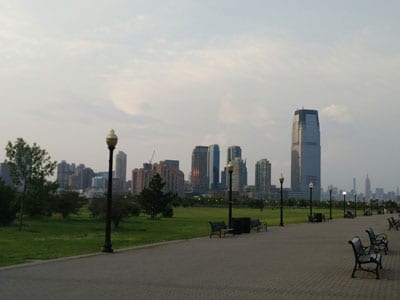Jersey City Factoring Company
Improve Your Cash Flow with Invoice Factoring
Invoice factoring, also referred to as accounts receivable financing or factoring, is a funding solution many companies use to improve their cash flow.
Our Jersey City invoice factoring programs work by selling your accounts-receivables to us instead of waiting on customer payment. We’ll deposit a high advance directly into your back account within 24 hours, eliminating your cash-flow gap caused by slow-paying customers. Once your customer pays the invoice days, weeks or even months later, we’ll deposit the remaining amount into your account, minus a small factoring fee.
 There are several benefits of choosing our Jersey City factoring company programs over others.
There are several benefits of choosing our Jersey City factoring company programs over others.
- Approvals in 15 minutes or less
- Free no-obligation quote
- Same-Day funding
- Online customer support
- Low rates
- High advances
- Dedicated account manager
- Professional collectors
- Credit and risk assessment services
B2B Industries Use Invoice Factoring
Many industries benefit from our Jersey City accounts-receivable financing and invoice factoring programs. Since 1994, we’ve helped a variety of B2B industries with their cash-flow needs.
- Transportation
- Oilfield Services
- Heavy Equipment
- Utility & Pipeline
- Technology
- Staffing Agencies
- Government Contractors
- Telecommunications
- Many More
Debt-Free Financing
Because our Jersey City factoring company programs do not create debt for your company, we’re able to provide funding to companies that sometimes are not able to obtain traditional funding from a bank.
If you’re waiting to get paid from slow-paying customers, we can work with you. Our debt-free financing solution is able to improve cash flow for companies that are starting up, expanding or having financial troubles such as tax liens, credit issues or bankruptcy.
Contact a financial expert at Scale Funding today to see how our Jersey City invoice factoring programs can help you take back control of your finances.
Jersey City
People are moving to Jersey City. In a New York Times article “Moving in New Jersey City? Join the Club!” in February 2016, the writer quoted the city mayor’s office who issued that “developers are rushing to build, with some 7,000 units of housing under construction and another 19,000 approved—more than any city in the state.” This is an impressive turnaround for a city that, just years ago, was known for crime and violence.
History
The Lenape (later called the Delaware Indians) inhabited the area that is now known as Jersey City. By the 17th century, the Dutch explored the territory, and Michael Reyniersz Pauw, a Dutch explorer, bought the land area from the Lenape. As part of his obligation to the Dutch West India Company, as landowner, Pauw was supposed to populate it with Dutch settlers. He failed to do so. Other Dutchmen took over the responsibility of looking after the area as a Dutch colony. They built houses on farmlands. One of them was called Pavonia, named after Pauw’s family.
The Dutch settlers soon found themselves in conflict with the Lenape. They disagreed about land ownership and trade relations. This brought a dark episode in Jersey’s history called the Pavonia massacre where several Native Americans were killed. The Lenape people fought back, forcing the Dutch to leave Pavonia.
In 1658, Peter Stuyvesant, the then Dutch colony director, bought back the area from the Lenape. This was a way of establishing peace with them. By 1675, the Dutch turned it over to the British after years of negotiation. On February 22, 1838 Jersey City became a local governing body.
During the early 20th century, lots of immigrants arrived in Jersey City. The Irish, Germans, and Italians are among those who went to the city to look for work. At around this time, the city was known for manufacturing, an industry that needed a lot of workers.
A Democrat, Frank Hague, was the city mayor from 1917 to 1947. Known in political history as a shrewd power player, Hague affected not just Jersey City politics but also the gubernatorial elections and the presidential elections. He silenced critics by making outrageous laws, such as asking for a police permit before making a political speech. He also banned several political meetings. He was said to take bribes from lots of influential people. The mayors that followed him could not even stop the reputation of the local government as one that was corrupt.
By the 1970s, the city was known for crime and violence. A lot of residents moved elsewhere to look for a more peaceful neighborhood. Joblessness also increased around this time.
The 80s, with the construction of high-rise commercial buildings and financial institutions like Goldman Sachs and Chase Bank putting up offices, saw the beginning of Jersey’s recovery.
In the second decade of the new millennium, Jersey City experienced a happy twist of fate. Just decades earlier, people were leaving the place. By 2016, people were moving there to live.
Geography and Climate
Jersey City has a total land area of 14,794 square miles. It is one of the cities that lie near the Hudson River. It is a part of Hudson County.
Historic Downtown, a place in Jersey City, is well-known because it is near Manhattan. Newport and Exchange Place are areas known for its commercial activities. Bergen-Lafayette, also called ‘The Hills’ has the largest municipal park in the city. The Heights is made up of low-rise residential buildings.
Jersey City is known for hot summers and cool winters.
Population
Based on 2015 estimate, the population is 264,290. It’s the second most populated city in the state, after Newark. The whites comprise 32 percent of the population, followed closely by African Americans at 28 percent. The rest are other racial types making this city as one of the most racially diverse in the US. One of the fastest growing ethnicities are the Filipinos, already about eight percent of the population.
Places to See
Goldman Sachs Tower is the highest building in New Jersey. It is 781-feet tall and has 42 stories. It is a sight to behold by day, and by night it is remarkably lighted.
The Empty Sky Memorial is dedicated to those who lost their lives during the September 11 attacks. The design was chosen by the survivors of the victims. It has walls that are reminiscent of the Twin Towers, with the names of those died written on them.


Little Manila is an area for those interested in Filipino culture. This where Filipinos meet and shop for Filipino food and crafts. Much of the businesses here are owned by Filipinos.
Van Vorst Park in Historic Downtown is a two-acre park, romantically beautiful with its 19th century and early 20th century revival architectural styles. It has two playgrounds, a splash park and a dog park. Films are shown in the park every other Wednesday from June to August. Shakespeare’s plays are also staged there by the famous people behind Shakespeare at the Park.
Loew’s Jersey Theatre recalls the movie palaces of the past before the advent of multiplexes. They show film classics, often ones that are just restored. Speakers, often those connected with the classic films, talk about the films before they are shown.
The Colgate Clock, facing the Hudson River, is a massive octagonal clock that is 50 feet in diameter. It is the official time for people who are scheduled to fly in the airport nearby.
Edward’s Steakhouse is a well-regarded restaurant located in a historic brownstone building. Its fried green tomatoes and the steak it calls Edward’s Duet are often talked about by foodies.
The Museum of Russian Art specializes in what is called as Soviet Nonconformist Art. It refers to art produced by Russian artists during the 20th and 21st centuries.
The Jersey City Museum is also home to modern art. It recognizes and exhibits visual artists who reside in New Jersey. Its shows are often written about in major publications like The New York Times.
Transportation
Buses, ferries, and trains are the means of public transport. More than 42 percent of the population takes the public transit to work. About 8 percent just walk to work. There are also a few bikeways for bikers. The major airport that the city is closest to is the Newark International Airport.
Famous People from Jersey City
Actors Nathan Lane and Michelle Rodriguez, musicians Frank Sinatra and Akon, Olympian Andy Stanfield, great NBA player Shaquille O’Neal, and TV personality Martha Stewart are some of the celebrities that are from Jersey City.


